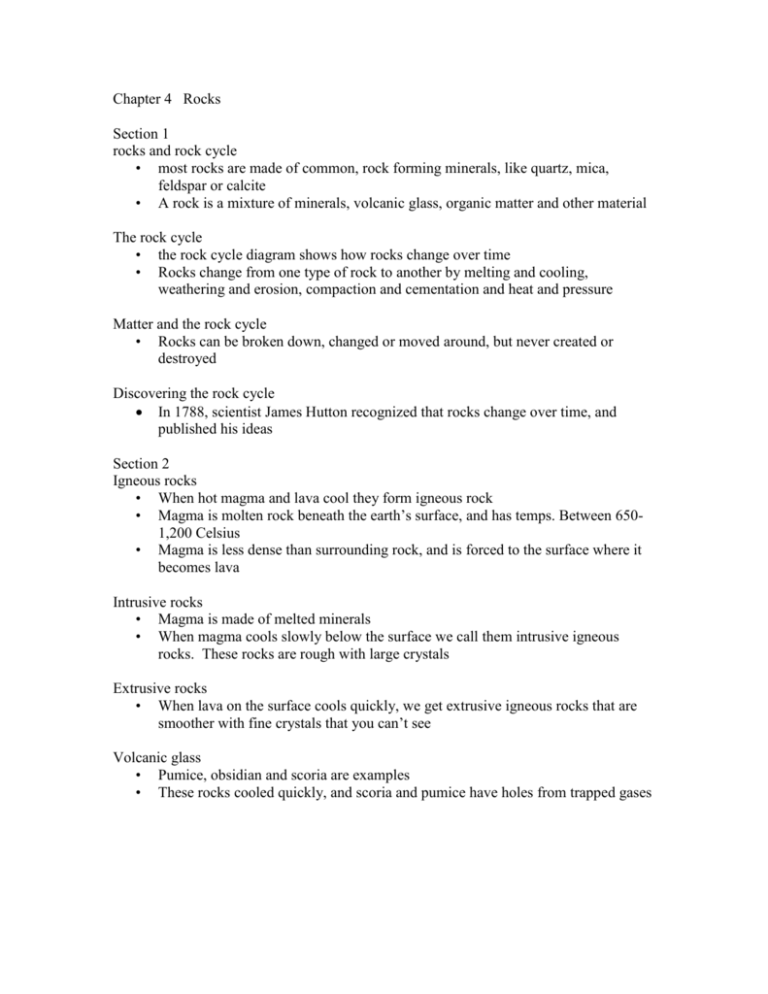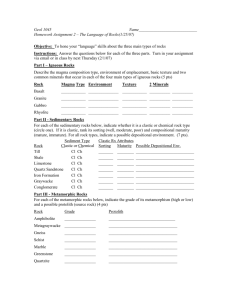chapter 4 Rocks notes
advertisement

Chapter 4 Rocks Section 1 rocks and rock cycle • most rocks are made of common, rock forming minerals, like quartz, mica, feldspar or calcite • A rock is a mixture of minerals, volcanic glass, organic matter and other material The rock cycle • the rock cycle diagram shows how rocks change over time • Rocks change from one type of rock to another by melting and cooling, weathering and erosion, compaction and cementation and heat and pressure Matter and the rock cycle • Rocks can be broken down, changed or moved around, but never created or destroyed Discovering the rock cycle In 1788, scientist James Hutton recognized that rocks change over time, and published his ideas Section 2 Igneous rocks • When hot magma and lava cool they form igneous rock • Magma is molten rock beneath the earth’s surface, and has temps. Between 6501,200 Celsius • Magma is less dense than surrounding rock, and is forced to the surface where it becomes lava Intrusive rocks • Magma is made of melted minerals • When magma cools slowly below the surface we call them intrusive igneous rocks. These rocks are rough with large crystals Extrusive rocks • When lava on the surface cools quickly, we get extrusive igneous rocks that are smoother with fine crystals that you can’t see Volcanic glass • Pumice, obsidian and scoria are examples • These rocks cooled quickly, and scoria and pumice have holes from trapped gases Classifying igneous rocks • Are either intrusive or extrusive • Igneous rocks form from basaltic, andesitic or granitic magma – b.a.g. of magma • Basaltic magma – dark colored, low in silica, fluid like, gentle eruptions • Granitic magma – light colored, high in silica, thick, explosive eruptions • Andesitic magma – color is between basaltic and granitic, explosive Section 3 Metamorphic rocks • Rocks that have changed because of heat and pressure or hot, watery fluids • The rock can change form, composition or both Heat and pressure • Deep in the earth minerals can be melted or flattened under the heat and pressure • Depending on the amount of pressure and temp., one rock can change into other rocks over time – For example, shale changes to slate then phyllite then schist and then gneiss Hot fluids Water with dissolved elements moves through rocks and change their composition Classifying metamorphic rocks • They can be foliated, having minerals that line up in layers, like slate • They can be non-foliated, where the minerals don’t line up, so they have no layers, like marble Section 4 Sedimentary rocks Sedimentary rocks form when sediments are pressed and cemented together, or when minerals come out of solution Stacked rocks • Sedimentary rocks that form in layers with the oldest layers on the bottom are called stacked rocks • Forces within the earth can sometimes turn over rock layers and change the order Classifying sedimentary rocks • Sedimentary rocks are made of pieces of all types of rock • They are classified as either detrital, chemical or organic sedimentary rocks Detrital sed. rocks • Made of fragments of other rocks that are weathered and eroded mechanically and chemically • naturally compacted and cemented together • Detrital rocks are named according to the size of their sediments Chemical sed. rocks • These form when dissolved minerals come out of solution • Halite and limestone come out of salt water Organic sed. rocks • These are made from remains of once living things • Coal forms from ancient plants • Chalk comes from crushed shells




